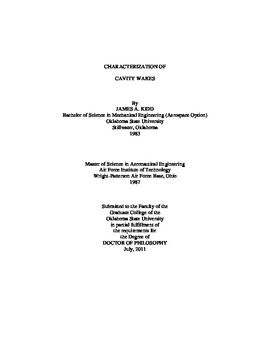| dc.contributor.advisor | Arena, Andrew S. | |
| dc.contributor.author | Kidd, James Allan | |
| dc.date.accessioned | 2013-12-10T18:05:17Z | |
| dc.date.available | 2013-12-10T18:05:17Z | |
| dc.date.issued | 2011-07 | |
| dc.identifier.uri | https://hdl.handle.net/11244/7800 | |
| dc.description.abstract | Scope and Method of Study: This research focused on flow over deep cavities at subsonic speeds with emphasis on the wake downstream of the cavity. Cavity wake behaviors have not been studied in detail and are a major concern for air vehicles with cavities and in particular for optical sensor systems installed in cavities. Other key behaviors for sensor survival and performance are cavity resonance and turbulence scales in the shear layer. A wind tunnel test apparatus was developed to explore cavity and wake characteristics. It consisted of a test section insert for the OSU Indraft Wind Tunnel with an additional contraction cone for significantly increased speed. The test section included a variable depth cavity in a boundary layer splitter plate/fairing assembly, a Y-Z traverse and pitot rake with in-situ pressure transducers for high frequency response. Flows were measured over clean cavities with length to depth (L/D) ratios of 4 to 1/2 and on cavities with a porous fence for resonance suppression. Measurements were taken in streamwise and stream sections to three cavity lengths downstream of the cavity trailing edge. Flow visualization using laser sheet and smoke injection was also used. | |
| dc.description.abstract | Findings and Conclusions: The high speed test section demonstrated a significant new capability for the OSU wind tunnel, reaching 390 feet/second in an empty 14” x 14” test section. Inlet room flow was found to be very unsteady and recommendations are made for improved flow and quantitative visualization. Clean cavity flow showed resonant frequencies well predicted by various versions of Rossiter's equation. Wake boundary layer thicknesses were roughly twice those of a normal turbulent boundary layer (TBL). Lateral thickness distributions showed asymmetries and peaks attributed to 3D effects from cavity length to width ratios and resonance state. The porous fence suppressed resonances for all L/D's except for L/D=1 where there was ~30 dB reduction versus the clean cavity. Turbulent intensities (TI) for both configurations were 35% to 55% with momentum thicknesses of 1.7 to 2.3 that of a TBL. Momentum thicknesses and TI's decayed to near that of a TBL by 3 lengths downstream. Clean configuration integral length scales were 1.7 to 2.3 times longer than a normal TBL. Fence configuration scaled were generally slightly shorter than the clean configuration. Fence flow visualization showed edge vortices and jets through the perforations that suggest the potential for optimization for turbulence intensity and scales. | |
| dc.format | application/pdf | |
| dc.language | en_US | |
| dc.rights | Copyright is held by the author who has granted the Oklahoma State University Library the non-exclusive right to share this material in its institutional repository. Contact Digital Library Services at lib-dls@okstate.edu or 405-744-9161 for the permission policy on the use, reproduction or distribution of this material. | |
| dc.title | Characterization of cavity wakes | |
| dc.contributor.committeeMember | Chambers, Frank W. | |
| dc.contributor.committeeMember | Jacob, Jamey D. | |
| dc.contributor.committeeMember | Weckler, Paul | |
| osu.filename | Kidd_okstate_0664D_11617.pdf | |
| osu.accesstype | Open Access | |
| dc.type.genre | Dissertation | |
| dc.type.material | Text | |
| dc.subject.keywords | cavity | |
| dc.subject.keywords | resonance | |
| dc.subject.keywords | turbulence | |
| dc.subject.keywords | wake | |
| thesis.degree.discipline | Mechanical and Aerospace Engineering | |
| thesis.degree.grantor | Oklahoma State University | |
